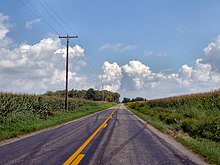
Highway hypnosis, also known as white line fever, is an altered mental state in which an automobile driver can travel lengthy distances, responding to external events in the expected, safe, and correct manner with no recollection of having consciously done so.[1] In this state, the driver's conscious mind is fully focused elsewhere, while seemingly still processing the information needed to drive safely. Highway hypnosis is a manifestation of the common process of automaticity.[2]
The concept was first described in a 1921 article that mentioned the phenomenon of "road hypnotism": driving in a trance-like state while gazing at a fixed point. A 1929 study, Sleeping with the Eyes Open by Walter Miles, also addressed the subject, suggesting that motorists could fall asleep with their eyes open and continue to steer.[3] The idea that this phenomenon could explain the unaccountable automobile accidents became popular in the 1950s.[4] The term "highway hypnosis" was coined by G. W. Williams in 1963.[3][5] Building on the theories of Ernest Hilgard (1986, 1992) that hypnosis is an altered state of awareness, some theorists hold that the consciousness can develop hypnotic dissociation. In highway hypnosis, one stream of consciousness drives the car while the other deals with other matters. Partial or complete amnesia related to the time spent driving under highway hypnosis can develop for the driver involved.